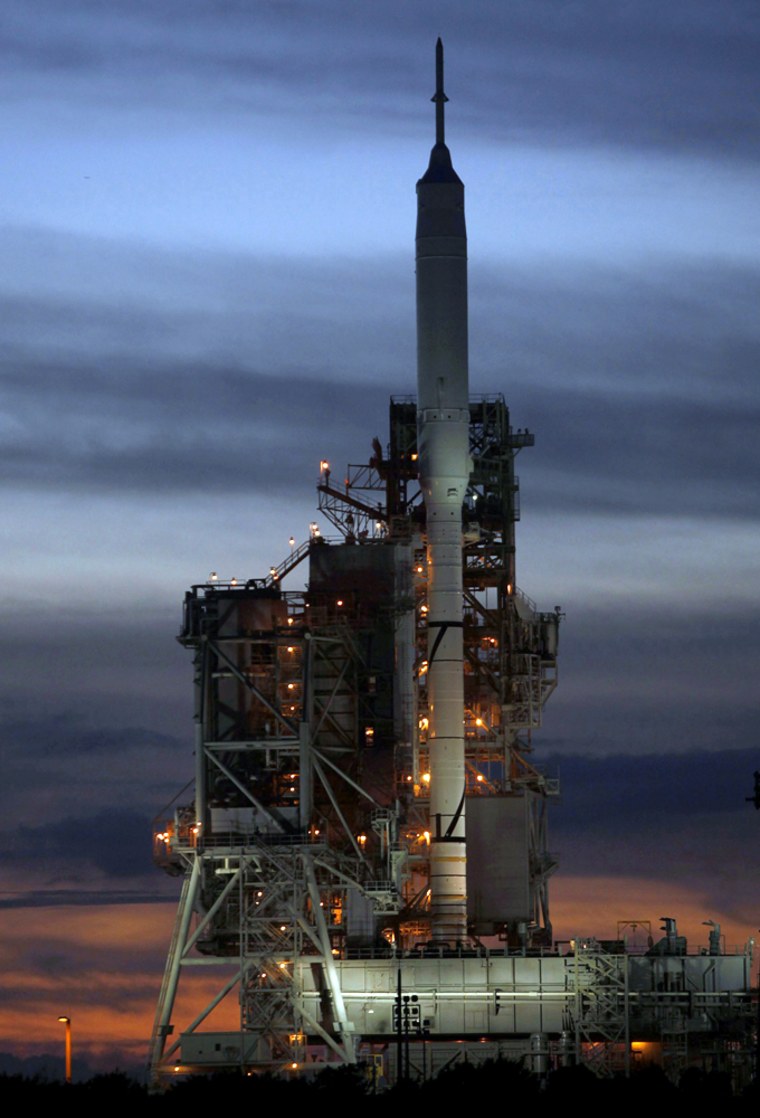Bad weather and a series of unlucky events thwarted repeated attempts by NASA to launch the prototype Ares I-X rocket on a test flight Tuesday.
Launch teams tried to launch the rocket several times over the course of four hours, but clouds, winds and the threat of rain prevented the flight. NASA says they will try again tomorrow morning at 8 a.m. ET.
At one point the $445 million rocket was poised to launch to take advantage of a brief window of clear skies, only to be hindered in the final minutes by an errant boat that had strayed into the danger zone which the rocket would fly over after liftoff. After that issue was cleared NASA intended to try again a few minutes later, but a cloud was spotted passing over the launch pad, violating weather concerns.
Before that, a sock that covered a sensor instrument on the top of the rocket got stalled as crews attempted to pull the cover off. But that issue, too, was resolved.
"There was huge applause here in the control room when it finally broke off and came clear," said Ares I-X deputy mission manager Jon Cowart. "Glad they got that turned around and got that fixed. But that did delay us."
The test rocket was originally slated to lift off this morning at 8 a.m. EDT (1200 GMT) from Launch Pad 39B here at Kennedy Space Center. NASA had until noon EDT (1600 GMT) today to loft the rocket before its four-hour launch window was up and the launch team had to stand down until Wednesday. All the booster needed was about 10 minutes of clear skies within that time.
Launch was often foiled by the "triboelectrification rule" - which prevents the vehicle from blasting off into clouds because it could trigger static electricity that may interfere with onboard instruments.
Slightly better weather conditions are expected for Wednesday, when weather officer Kathy Winters has predicted a 60 percent chance of clear skies. That's an improvement over Tuesday's forecast, which held only 40 percent odds of favorable weather.
"I feel more optimistic about Wednesday than Tuesday," Winters said over the weekend.
Ares I-X is the first trial version of NASA's Ares I booster, a next-generation rocket intended to replace the space shuttle as a vehicle to carry astronauts to low-Earth orbit and, ultimately, on missions to the moon. The test rocket includes a real solid-rocket first stage, with a dummy second stage and mock Orion crew module atop it.
If Ares I-X does not launch this week, NASA may have to stand down until sometime in November due to other launch traffic, including a shuttle mission slated to lift off from a nearby launch pad Nov. 16. The 327-foot (100-meter) rocket, currently the world's tallest booster capable of launching, may have another chance to fly Thursday, mission managers have said.
Next-generation spacecraft
The Ares I-X flight is expected to last a little over two minutes. The rocket is slated to loft eastward, reaching a maximum altitude of about 150,000 feet, or 28 miles (46 km), before arcing back down into the Atlantic Ocean.
The mission's purpose is to collect data on the rocket's design and performance. Cameras on the ground and aboard an airplane will gather visual evidence of the rocket's flight, while over 700 sensors onboard will record comprehensive measurements.
As an untested rocket, the mission does come with a higher degree of risk than the more routine space shuttle missions, managers said.
"There are no guarantees," Ares I-X mission manager Bob Ess said on Monday. "We think we're ready to go from a vehicle point of view. The whole point of tomorrow is to learn from it."
In fact, the novel aspect of the experimental flight is exciting to the rocket scientists.
"This developmental flight test stuff is a lot of fun," said launch director Ed Mango.
Future plans
Regardless of the outcome of Ares I-X, the ultimate fate of Ares I remains uncertain. Plans for the rocket, along with the Constellation program under which it falls, are under review by the Obama administration. A presidential panel submitted a report last week summarizing NASA's plans and offering a set of options for the future.
The report suggested that NASA abandon Ares I and allow commercial companies to step in and provide a vehicle capable of transporting humans to low-Earth orbit. That way, NASA could focus on building spacecraft to take people back to the moon and beyond.
The space agency has been working to ready the Ares I rocket and Orion crew capsules for operation in 2015 with the goal of returning to the moon by 2020. But the recent review found that the new rocket and spacecraft will likely not be ready until 2017.
Constellation program manager Jeff Hanley said the upcoming flight test would be useful, even if Ares I is never to be built.
"It's certainly incredibly important to the Ares I," Hanley said. "It is just as important to any future human launch system that you might want to build. And of course it's important in terms of our overall plan for the Constellation program."
